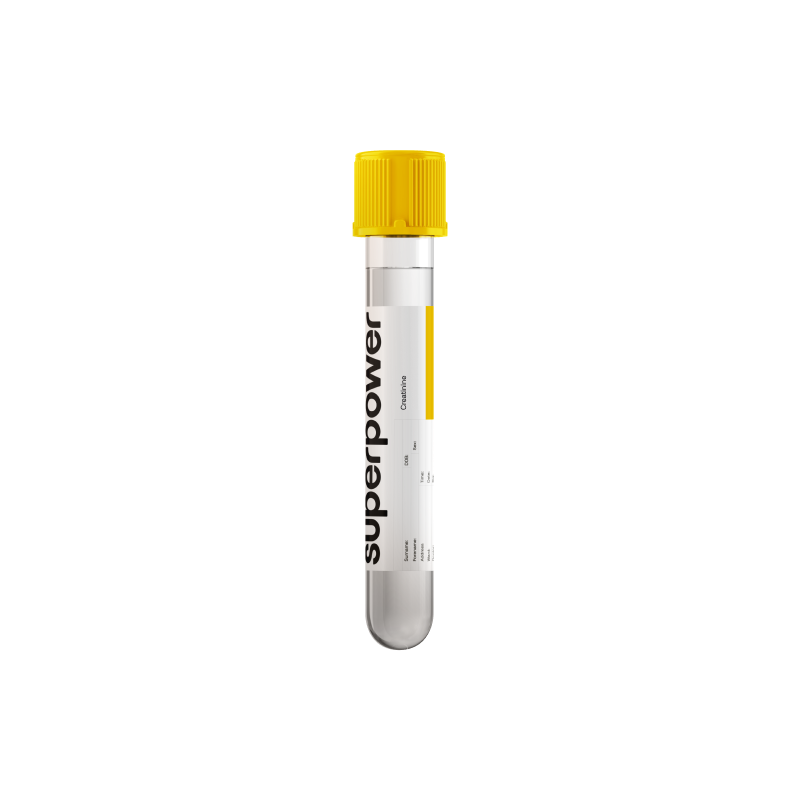Creatinine testing provides a real-time signal of kidney filtration and muscle activity.
Interpreted with eGFR and lifestyle context, it helps spot silent kidney stress early, guide safe medication use, and optimize training, recovery, and long-term health.
Key Benefits
Check kidney filtering power with blood creatinine and your estimated filtration rate (eGFR).
- Spot early kidney stress from dehydration, medications, meat intake, or urinary blockage.
- Clarify causes of swelling, fatigue, or high blood pressure by assessing kidney function.
- Guide safe medication dosing for antibiotics, diabetes drugs, and kidney‑affecting pain relievers.
- Protect fertility by detecting kidney disease that can disrupt hormones, cycles, or sperm health.
- Support a safer pregnancy; normal pregnancy lowers creatinine, and rises need urgent review.
- Track trends to catch acute kidney injury early and monitor chronic disease progression.
- Best interpreted with eGFR, urine albumin (ACR), and sometimes cystatin C for accuracy.
What is Creatinine?
Creatinine is a small waste molecule made when muscles use creatine for quick energy. As creatine and phosphocreatine break down, they spontaneously form creatinine at a fairly steady rate tied to muscle mass. Creatinine leaves muscle, circulates in the bloodstream, and is removed by the kidneys as it is filtered from the blood into urine (glomerular filtration). It does not have a purposeful job in the body; it is a byproduct of normal muscle metabolism.
The significance of creatinine is what it reveals about kidney filtration. Because it is produced continually and is mostly cleared by the kidney filters (glomeruli), its concentration reflects how well the kidneys are clearing small solutes, summarized as glomerular filtration rate (GFR). Small amounts may be secreted by kidney tubule cells, and production varies with muscle mass, but overall creatinine provides a practical, accessible window into kidney filtering performance in daily life.
Why is Creatinine important?
Creatinine is a small waste molecule made at a steady rate by your muscles and cleared almost entirely by the kidneys. Because production depends on muscle mass and removal depends on kidney filtration, it acts as a bridge marker between the musculoskeletal system and renal function, with ripple effects on fluid balance, electrolytes, and blood pressure regulation.
Healthy results sit within a lab’s reference range and are lower in women and children, higher in men and very muscular people, and typically fall during pregnancy as filtration increases. For kidney health, stability around your personal baseline matters more than chasing very low numbers.
When the value runs low, it often reflects reduced muscle mass—sarcopenia, frailty, malnutrition, or chronic illness—and can be seen in advanced liver disease. In pregnancy, a modest decrease is physiologic. People may notice weakness or reduced exercise capacity more than kidney symptoms. Importantly, very low muscle mass can make kidney function appear better than it truly is, especially in older adults and smaller-bodied women, potentially misclassifying risk.
When the value runs high, it signals that kidney filtration has fallen—acutely (illness, dehydration, obstruction, medication effects) or chronically (kidney disease). Symptoms can include swelling, fatigue, nausea, reduced urine, itching, cramps, and rising blood pressure, reflecting disturbances in salt, potassium, and acid-base balance. In children and teens, even small rises are meaningful; in pregnancy, elevation is worrisome.
Big picture: creatinine links muscle metabolism to kidney clearance and underpins estimated GFR and drug dosing. Persistently elevated levels track with chronic kidney disease, cardiovascular events, anemia, and bone–mineral disorders. Interpreting it alongside cystatin C and urine albumin paints a fuller view of long-term renal and cardiovascular health.
What Insights Will I Get?
Creatinine is a muscle‑derived waste in blood, formed at a steady rate from creatine used for rapid energy. The kidneys clear it mainly by glomerular filtration (GFR). Because output reflects muscle mass and clearance reflects kidney function, creatinine links cellular energy use to whole‑body balance: fluids, acid‑base, blood pressure, and toxin removal.
Low values usually reflect lower production or higher clearance. Small body size, aging, chronic illness, pregnancy (higher filtration), and female sex commonly lower it. It can also signal low muscle reserve, low protein intake, liver disease (less creatine synthesis), or hyperthyroidism, and may mask early kidney impairment.
Being in range suggests steady muscle turnover and normal kidney filtration (GFR) for age and sex. In healthy adults, optimal often sits near the mid‑range; it trends lower in pregnancy and in younger, lean people with high filtration.
High values usually reflect reduced filtration (lower GFR) from acute or chronic kidney dysfunction, volume depletion, or urinary obstruction. Increased production can also raise it: larger muscle mass, recent strenuous exercise or muscle injury, a meat‑heavy meal, or hypothyroidism. In pregnancy, even modest rises are more concerning.
Notes: Interpret with context: age, sex, baseline, trend, and eGFR. Assays differ (Jaffe vs enzymatic) and can be influenced by bilirubin or ketones. Drugs that block tubular secretion (cimetidine, trimethoprim, fenofibrate) and timing after cooked meat can transiently elevate results.



.svg)



.png)
.png)
.png)
.png)








